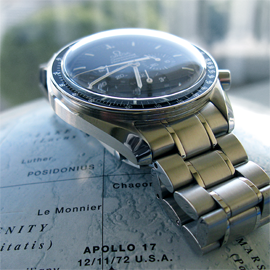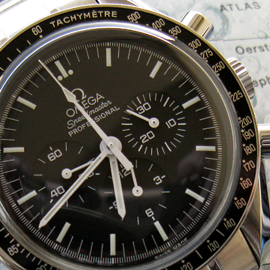Speedmaster Pro (review)
(This review covers the Omega Speedmaster Professional 3570.50.00. There are many variants and special editions, etc.)
The watch does two things: tells time and tells time elapsed.1 Beyond that, it plays wonderfully as an artifact—of the era of manned space exploration, of mid-century design, and of the modern wristwatch. As a Swiss creation, it is mid-century and mid-continent, yet somehow transatlantic and American, an otherwise unassuming thing, amazingly natural in the company of a Vitra chair, an Eichler home, or the Space Center of Houston, Texas. (That city being the home to the jeweler that sold the first Speedmaster considered as flight equipment by NASA.)
The Speedmaster was first released in 1957, ten months after the Eames Lounge Chair was first exhibited. The two have remarkable qualities in common (not the least of which being price). They are each a marriage of potent design and modern materials. They're also deftly ergonomic in unexpected ways. They both make a first impression as expressions of artful and accidental invention. Extended use however, brings to light exacting design decisions in the service of ergonomics, not egomania.
Impressions
When brought to the ear, the watch ceaselessly chatters. As a manual/mechanical, a daily twenty twists of the crown unspool at six ticks a second thorough the day and night. It has a tall, convex miniscus of Hesalite crystal, a shatter-proof plastic. The crystal sits high above the face of the watch and at angles the refraction tugs at the hour, minute, and fifth-of-a-second hash marks. At the edges, the effect is one you might expect in a time travel sequence in 1960’s cinema.
The face of the Speedmaster is clear and communicative even at a glance, but it rewards a closer reading. At first the face appears as white lettering and hands on a black field. After close examination under many conditions the consensus is more a creamy off-white, and the black actually a field of matte off-black with elements of brown, which is most visible in intense direct sunlight. In that light, the field takes on an almost-sandy texture as the sunlight is reflected in a tiny glint of color. The hands and the hour marks are made even more complex due to phosphorescent paint (called Super-luminova by Omega). In daylight, the paint gives the white elements faded lime color. In darkness the face is an otherworldly landing zone lit with green. Of course the glow fades in time, but the sharp, contrasty elements make it easy to read time in dark surroundings.
Certainly a coincidence, but the watch pulls all of its colors from a distinctly lunar palette.
The attention to detail, surely not unique to Omega, or fine watches overall, is impressive. A tiny inverted omega letter is etched into the interior of the crystal, above the center shaft. The watch makes six discreet typefaces all work in harmony, no easy feat. The hour marks point boldly toward the center. Perhaps as a punch-line, the 12 o’clock hour mark sits between two curious circles, perhaps reminding the wearer that the piece is safely masculine.
The Smaller Dials
Arrayed around the center of the face, the three smaller dials form a pleasing symmetry with the manufacturer name and logo—elements which are themselves clustered in a sort of triangle, the angles of that triangle, starting from the center of the greek letter, point directly at the center of the seconds dial to the left, and the chronograph-minutes dial to the right.2 The dials are gently carved out of the matte, as if the white dials have over time pushed hourglass sands to the edge of their compass description.
To a watch neophyte, the most unexpected element of operation was that seconds were counted not by the longest, thinnest hand of the main dial, but down in one of the smaller dials. There, the second hand ticks, resting nearly imperceptibly at the sixths-of-a-second.
The structure and function of the chronograph is a study in elegant ratios. The minute dial (on the left) counts to 30 minutes, not 60, improving legibility . And its dial snaps to the minute, moving smartly from one hash to the next only in the two seconds preceding the top of the minute. The hour dial (center bottom) counts 12 hours, with its hand moving imperceptibly at the top of each minute. Of course the lanky center seconds hand ties the others together to measure time. The longest in the watch, it sits at the top of the pivot, pointing at noon when not in use and smartly splitting the omega. It is the only hand with a tail.
As the chronograph runs, it plays an elegant fugue of the presentation of time: the minute hand is always fixed on a specific number, the hour hand indicates a general position within the hour, indicating if the minutes hand is above or below 30 minutes. The center second hand sweeps boldly across the face. The dials can be read individually, each rendering discrete information, or read together as a propositional phrase—the angle of the dials quickly translating to form nouns and adjectives: quarter-past-the-hour, 11 minutes and fifty seconds, 34 seconds and four sixths exactly.
Until I had made use of the chronograph several times, and under different conditions, the care and attention paid to making it easy to tell elapsed time at a glance was not evident. It’s clear that the same thought that would go into the instrumentation for an aircraft cockpit—a towering example of man-machine connectivity—went into this aviation watch.
Beyond the Face
The watch is heavy. The bezel is thin, displaying a tachymeter gradient. Unlike a diving bezel so prevalent on many sports watches, this ring is subtle: the deep black gloss and silver type work well to bind the moving visuals at the center of the watch—hands, dials, hashes—into a solid whole. The watch has a refreshing lack of the colorful and heavy type of a diving watch.
The back of the watch remains philosophically consistent with the front. It reveals nothing about its mechanics. There is no window, only a deep relief seal depicting the Hippocamp, which often appears on Speedmasters and its diving sibling the Omega Seamaster.3 Surrounding the seal is a statement that it was the first watch worn on the moon.
Dedicated horophiles will cite the above credentials as a story that few other watches can match. Along with a bunch of other fine chronographs of the time, the Speedmaster was purchased by two NASA engineers for testing as a flight watch for use in space. Following a battery of tests of heat, pressure, vibration, and abuse, it beat out all of the others for reliability, safety, and durability for use in microgravity and the vacuum of space.
The watch is one of just a handful ever to be in space, the first to accompany a US astronaut on EVA, and the first on the moon. It’s successors are still preferred equipment on many US, Russian, and European space flights.
Conclusion
This review is laden with qualifiers like nearly, almost, and subtle. It's a testament to the concept and manufacture of this watch that simple statements of observation require such contorted language. The design and function works at such wonderfully detailed level that those qualifiers are needed. On the arm and in the eye, it’s a beautiful artifact of confidence in technology, an era of no limits. An era it seems time has left behind.
More
As a price control, Omega watches are embargoed from official sale over the internet.
Resources that cover more about the trivia, movements (cal. 1861 and 321), and evolution of the Speedmaster and its Omega brethren:
- Wikipedia entry (good)
- The Right Stuff: Inside the Omega Speedmaster Professional (a massive, multipart "biography" of the watch)
- "Speedy" obsessives site (good for researching vintage models or the refreshingly sluggish evolution of the design as a whole)
- Timezone Forums
Notes
1. A third function, the tachymeter requires an outside agent. 2. Jack Foster, The Right Stuff: Inside the Omega Speedmaster Professional 3. Thanks to many members of the timezone.com Omega forum for details like this and many other corrections.
Posted August 16, 2008.


